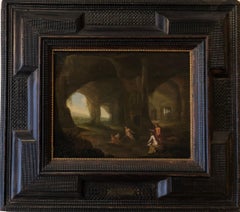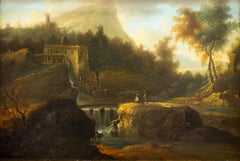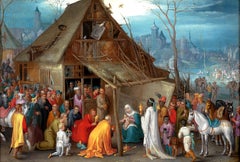Abraham van Cuylenborch Art
1620-1658
Abraham van Cuylenborch was a Dutch Golden Age landscape painter. Cuylenborch enjoyed great success with his pictures amongst contemporary critics and collectors. A preference for imaginary views was the most striking characteristic of Utrecht landscape painting in the 1st half of the 17th century. In other parts of the region, artists concentrated on Dutch landscapes or city vedute. Cuylenborch’s oeuvre consists largely of such grotto. Aside from him, only Dirk Stoop and Carel de Hooch were producing comparable cave pictures in Utrecht. Outside Utrecht, his only competitor was the Amsterdam painter, Rombout van Troyen.
to
1
1
1
Overall Height
to
Overall Width
to
1
1
1
1
6,996
3,348
2,513
1,213
1
1
Artist: Abraham van Cuylenborch
17th Century Classical Oil Painting - Diana With Her Attendants in a Grotto
By Abraham van Cuylenborch
Located in London, GB
Abraham van CUYLENBROCH (1620-1658)
Diana With Her Attendants in a Grotto
1651
signed
oil on panel
12.2 in x 15.7 inches, inc. frame;
31 x 40 cm
Provenance:
Sale of Sotheby's Lo...
Category
17th Century Old Masters Abraham van Cuylenborch Art
Materials
Oil
Related Items
Italian Landscape With Figures at a Waterfall by a Follower of Jan van Huysum
By Jan Van Huysum
Located in Stockholm, SE
There are so many details to fall in love with in this 18th-century painting depicting an Italianate landscape, for example, the delicately painted figures having a conversation and ...
Category
Early 18th Century Old Masters Abraham van Cuylenborch Art
Materials
Oil, Wood Panel
The Adoration of the Magi by Joseph van Bredael
Located in New Orleans, LA
Joseph van Bredael
1688-1739 Flemish
The Adoration of the Magi
Oil on copper
Painted on copper and exhibiting an exquisite luminosity, this exceptional painting...
Category
Late 17th Century Old Masters Abraham van Cuylenborch Art
Materials
Copper
H 12.5 in W 16.75 in D 1.5 in
A 17th Century Mythological Scene
Located in Stockholm, SE
This small yet captivating painting, crafted on a copper plate, dates back to the mid-1600s and was created by a Flemish artist.
Subject Matter: The central figure in the artwork is Mercury, easily identified by his symbolic attributes like winged sandals, petasus, and caduceus. Beside him is a likely female figure, characterized by her attire and absence of weaponry.
The depicted scene could represent two mythological tales:
Mercury and Calypso: This interpretation suggests the artwork shows the moment Zeus sends Mercury to Calypso's island, Ogygia. Mercury is there to order Calypso to release Ulysses, whom she saved from a shipwreck but kept captive. The lush, wooded background and the three distant figures could hint at Ulysses' farewell to Calypso.
Mercury and Herses: Another interpretation could be a scene from the love story of Mercury and Herses. The background figures might symbolize the sisters returning from a procession, while the forefront could be the initial meeting between Mercury and the most beautiful sister, Erse.
Artistic Inspiration: The painting's landscape and setting are heavily influenced by the early 17th century Northern European art trends, especially the works of Jan Brueghel the Elder. However, the artwork stands apart with its unique luminescence in detailing and a distinctive approach to depicting figures.
While the exact origin and artist remain somewhat mysterious, the style and treatment of light hint towards works close to Josse de Momper...
Category
Mid-17th Century Old Masters Abraham van Cuylenborch Art
Materials
Copper
Abraham and the Sacrifice of His Son Isaac by Adriaen Van Stalbemt, C. 1605-1610
Located in Stockholm, SE
Artist: Adriaen van Stalbemt (Stalbempt) 1580-1662
Title: Abraham and the Sacrifice of His Son Isaac “Das Opfer des Abraham”
According to the Old...
Category
Early 1600s Old Masters Abraham van Cuylenborch Art
Materials
Copper
Free Shipping
H 8.08 in W 9.97 in
19th Century Roman Landscape oil on canvas with Giltwood Frame
Located in Rome, IT
Amaizing 19' century Roman landscape depicting a part of Villa Borghese with Trinità dei Monti.
With a finely carved gilt wood coeval frame.
Measurements with frame cm 65 x78 wit...
Category
19th Century Old Masters Abraham van Cuylenborch Art
Materials
Oil
18th Century English Marine Oil Painting on Wood Panel Fishing Boats Stormy Sea
Located in Cirencester, Gloucestershire
Stormy Seas
English School, 18th century
oil on thick wood panel, unframed
panel: 25 x 30 inches
provenance: private collection, East Anglia, England
condition: very good and sound c...
Category
18th Century Old Masters Abraham van Cuylenborch Art
Materials
Oil
Moses Strikes the Water from the Rock. XVII cent. Dutch school.
Located in Firenze, IT
Moses Strikes Water from the Rock Dutch school, XVII century. Workshop of Jacob de Wet (Haarlem, 1610-1675).
Technique: Oil on oak wood panel, composed of 3 horizontal panels.
In this evocative work, Moses stands in a cave, gathering the Israelites. There was no water to drink or for their cattle. The people were discontented in the desert.
But Moses and Aaron listened to the voice of God. With Aaron’s staff, Moses struck the rock, and water gushed forth abundantly, quenching their thirst.
Jacob de Wet’s workshop specializes in subjects from the Old and New Testaments.
The recognizable rectangular format, simple compositions, and clear narratives define his style. The interplay of light and shadow, reminiscent of Rembrandt, adds timeless allure. The characters’ costumes, with their large hats and turbans...
Category
17th Century Old Masters Abraham van Cuylenborch Art
Materials
Oil, Wood Panel
Amsterdam Harbour Scene with Figures Dutch 17th Century art marine oil painting
Located in London, GB
This superb Dutch 17th century Golden Age Old Master cityscape oil painting of Amsterdam is by noted artist Jacobus Storck. Painted circa 1670, ...
Category
17th Century Old Masters Abraham van Cuylenborch Art
Materials
Oil
Rest on the Flight into Egypt - Attributed to Pieter Van Avont - 17th c. Flemish
By Pieter van Avont
Located in PARIS, FR
Rest during the Flight into Egypt - The Virgin and Child with St. John the Baptist and the angels in a Landscape.
Attributed to Pieter Van Avont (1600-1652)
17th century Antwerp School, circa 1630
Oil on oak panel,
Dimensions: h. 38 cm, w. 50 cm (14.96 in x 19.68 in)
Flemish style frame in ebonized and moulded wood
Framed: h. 56 cm, w. 68.5 cm (22.04 in. x 26.97 in.)
In the heart of a lush wooded landscape, the Virgin with Jesus rests in a green clearing accompanied by Saint John the Baptist and the cherubs. Seated to the left of the composition, the Virgin Mary holds the Child on her lap; the little Saint John the Baptist wearing the camel-skin tunic (his attribute) stands before Jesus to exchange a few caresses. On the right, the couple of cherubs are playing with the lamb of Saint John the Baptist, bringing a jovial character to the scene. A pair of gardening putti on the left pick flowers to bring bouquets to the Virgin and Jesus. Spring flowers such as tulips, daffodils and anemones that grow abundantly around them and enrich the composition with their shimmering colors. A lush rose bush blooms to the left of the figures offering delicate roses. (The rose is the flower associated with the Virgin Mary, who is the "mystical rose," the one that does not bear the "thorn of sin")
At the feet of the Virgin are bunches of grapes (symbol of the future passion of Christ) as well as apples (symbol of the original fall of Man but also of the Redemption in Christ) In the foreground we find a wicker basket filled in profusion with beautiful flowers and guinea pigs nibbling on the blades of grass. In a cleverly arranged disorder, these elements of the still life with their strong symbolic power accentuate the religious theme, but are also an opportunity for the artist to demonstrate his know-how in the still life genre that is gaining momentum in Antwerp. The landscape behind the figures consists of a large tree with a twisted trunk and a luminous opening to the horizon placed on the right. We see Saint Joseph arriving with a donkey, a small reminder from the artist that the composition is associated with the episode of Rest during the flight into Egypt.
The calm expanse of this bucolic forest opening onto the luminous distance, with its profusion of symbolic flowers and fruits, is particularly suited to this sacred scene. The theme of Jesus' sacrifice and his tragic fate is mitigated by cherubs who play with innocence and carelessness in the face of the fragility of life symbolized by cut flowers. The great mastery of the painter is manifested by the finesse of the drawing enhanced by the delicacy in the application of the brushstrokes bringing a multitude of details. The richness of the whole is exacerbated thanks to the choice of colours, this varied palette is an undeniable asset of our work.
The virtuosity of our artist lies in his versatility, as much concerned with the success of the landscape and flowers as with the modelling of his figures. The cherubs with their naked bodies are gracefully illuminated by warm colours with subtle shadows, while the still life is rendered with astonishing realism, both in the precision of the drawing and in the countless shades of the flowers.
There are several compositions similar to ours, of which below are the closest versions:
• Sale, Jean-Claude Anaf et Associés, Lyon, 08/02/1998, attributed to Pieter Van Avont, oil on panel, h. 48 cm, l. 71 cm (recorded on RKD n° 31451). Comment: identical composition, only St Joseph with the donkey is different)
• Christie's New York sale, 29/01/1998, Pieter Van Avont, oil on copper, h. 23.8 cm, w. 24.8 cm
• Dorotheum sale, Vienna, 25/04/2017, Pieter Van Avont and Jan Breughel II, oil on copper, h .26 cm, w. 39 cm
• Hermitage Museum, Saint Petersburg, Russia, Pieter Van Avont, oil on panel, h. 50.5 cm, w. 71.7 cm
Peter van Avont, Flemish painter (Mechelen, 1600 - Antwerp. 1652)
Born in Mechelen, he is mentioned in 1620 as a member of the painters' guild of his hometown. He left in 1 622 for Antwerp, where he was also a member of the guild. He collaborated with many painters, including Jan Brueguel the Younger, David Vinckboons, Lucas van Uden...
Category
17th Century Old Masters Abraham van Cuylenborch Art
Materials
Oak, Oil
H 22.05 in W 26.97 in
Wooded Figurative River Landscape - Dutch 17thC Golden Age art oil painting
Located in London, GB
This superb 17th century Dutch Golden Age oil painting has been more recently reattributed to Abraham Begeyn by Dr Marijke C. de Kinkelder formerly of the RKD - Netherlands Institute...
Category
1640s Old Masters Abraham van Cuylenborch Art
Materials
Oil
Landscape With Pan and Syrinx, Flemish School From the 1600s, Oil on Copper
Located in Stockholm, SE
Flemish School, 1600s
Landscape With Pan and Syrinx
painted around the 1600s
oil on copper
19 x 23.5 cm
frame 29 x 34 cm
Hand-made oak frame by Swedish frame maker Christer Björkma...
Category
17th Century Old Masters Abraham van Cuylenborch Art
Materials
Copper
H 11.42 in W 13.39 in
Antique English 19th century marine scene
By William Anderson
Located in Woodbury, CT
Outstanding English late 18th / early 19th century marine scene by one of Britain's best known and sought after painters.
William (or Wiliam) Anderson (1757 – 27 May 1837) was a Scottish artist specializing in maritime and patriotic themes. He was well-regarded for his detailed and accurate portraits of ships under sail, exhibiting his works annually in London between 1787 and 1811 and then occasionally until 1834. Anderson influenced other artists, notably John Ward and others of the Hull school.
Anderson's early life is obscure, but he is known to have trained as a shipwright before moving to London to become a maritime painter when he was about 30. His training served him well as a painter, providing "a practical nautical knowledge" of his subjects. He earned a reputation for "accuracy and refinement of detail" and was admired for his bright, clear colours. He worked in both oils and watercolours.
He based his style on that of well-known Dutch maritime...
Category
1810s Old Masters Abraham van Cuylenborch Art
Materials
Oil, Wood Panel
Abraham Van Cuylenborch art for sale on 1stDibs.
Find a wide variety of authentic Abraham van Cuylenborch art available for sale on 1stDibs. You can also browse by medium to find art by Abraham van Cuylenborch in oil paint, paint and more. Much of the original work by this artist or collective was created during the 18th century and earlier and is mostly associated with the Old Masters style. Not every interior allows for large Abraham van Cuylenborch art, so small editions measuring 16 inches across are available. Customers who are interested in this artist might also find the work of Flemish School, 17th Century, Jean-Baptiste Monnoyer, and George Morland. Abraham van Cuylenborch art prices can differ depending upon medium, time period and other attributes. On 1stDibs, the price for these items starts at $7,417 and tops out at $7,417, while the average work can sell for $7,417.


